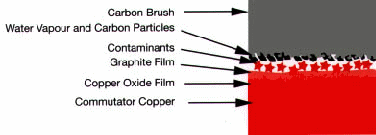S.C.B Surface Cleaning Brush
Combats Contaminated Environments
- Can be used with any brush grade
- One SCB per brush track
- Consistent with existing brush design
- Minimises commutator wear
- Reduces wear on existing brushes
- Can be made in 'fit and forget' style
The Surface Cleaning Brush has been developed to fight non-conductive Slip-ring/commutator patinas that occur in contaminated environments. The slipring/commutator patinas are a complex formation of approximately 75% copper oxide, 20% graphite, with water and environmental contaminants making up the remaining few percent. The balance of these ingredients is critical to the proper brush and commutator life.
An SCB consists of a conductive abrasive insert within a carbon brush. MORGAN INDUSTRIAL CARBON formulates and positions the abrasive material to make each SCB compatible to its application. Thus an SCB does not limit output during its temporary use. An alternative design incorporating a short length (stub) of SCB material enables 'fit and forget' use where the stub performs its function and wears away leaving the normal brush.

How an S.C.B. works
An increase in the amount of contamination (hydrogen sulphide, sulphur dioxides, chlorine, acid etc.) in the air can cause the slip-ring/commutator patina to be less conductive than intended.
The less conductive patina affects current sharing between the brushes, friction and commutation. Increased friction and poor commutation reduces brush life and can damage commutator surfaces.
Severe contamination can begin to affect the brush performance within a week. The paper, plastic, steel and chemical industries initiative to reduce maintenance cost and decrease downtime can be severely hampered by unscheduled failures caused by chemical vapour.
In a normal contaminated environment, brush impregnation's or treatments can protect the slip-ring/ commutator surface. Many times the contamination is so great that the patina cannot be properly formed. The SCB will control slip-ring/commutator film build-up in a contaminated environment.
A conductive scrubbing material is secured between the wafers of the brush. The material removes the contamination from the rotating surface maintaining the proper brush contact drop and friction characteristics.
The SCB is gentle on the slip-ring - commutator.
Surface Cleaning Brush Application
Copper commutators and bronze or steel slip-ring/commutators can react with the contaminants or moisture in the atmosphere forming a high resistance patina. This patina adversely affects the conduction of electricity. Copper reacts with sulphur compounds such as sulphur dioxide, chlorine or acids. If a non-conducting patina forms on the commutator/slip-rings, arcing may result as current passes between the brush and the commutator/slip-ring surface. Arcing can cause accelerated brush wear and damage to the commutator/slip-ring resulting in increased maintenance requirements or even the failure of the equipment. The SCB will provide cleaning action to control non-conductive patinas
Installation
Replace a standard brush with a compatible SCB. Usually one SCB per brush path will suffice. More than one may be installed if the commutator or slip-ring is very large or has severe contamination problems.
Monitor the progress of the SCB action. As soon as the surface has been restored, re-install the standard brush(es). SCB's can be reused.
How to order
To order the SCB to properly suit your machine please supply Morgan Industrial Carbon with details of the standard brush being used and specifications of the machine.
|
